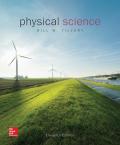
Concept explainers
A naturally occurring inorganic solid element or compound with a crystalline structure is a
a. mineral.
b. crystal.
c. rock.
d. stone.
From the following options, the naturally occurring, inorganic solid element or compound which has a crystalline structure is called:
mineral.
crystal.
rock.
stone.
Answer to Problem 1AC
Solution:
Option (a) is correct.
Explanation of Solution
Introduction:
Minerals are the part of solid materials of earth’s crust having known chemical composition and well-defined crystalline structure. The unique chemical composition and crystal structure gives it a set of physical property that is harnessed through engineering and technology to meet human needs.
Explanation:
Reason for correct option:
Minerals are obtained from the earth’s crust which is a thin layer of lighter elements on the surface. So, minerals are strictly naturally occurring.
Since the composition of minerals mostly includes any of the eight elements (Oxygen, Silicon, Aluminium, Iron, Calcium, Sodium, Potassium, Magnesium). So the product is inorganic in nature.
The atoms of a mineral are arranged in a regular and repeated pattern which is called crystal structure. The uniqueness of the crystal structure gives minerals special physical and chemical features.
Note that while discussing minerals ignore organic minerals which are some rare groups of minerals chemically containing hydrocarbons.
Also, petroleum being naturally occurring and obtained from earth’s crust should not be misunderstood as mineral as it is in liquid state and it is organic in composition. It is classified as hydrocarbon.
Hence, option (a) is correct.
Reason for incorrect option:
Option (b) is incorrect because crystals can be manufactured by the process of crystallization. Crystals may exist in either solid or frozen non-crystalline state.
Option (c) is incorrect because rocks are not elements or compounds but an aggregation of minerals and other materials. The minerals may be of same type or different types. Aggregation may include materials that don’t have crystal structure.
Option (d) is incorrect as there is no major difference between a rock and stone chemically. The stones are smaller in size compared to rock.
Conclusion:
All the solid materials of earth crust that have unique chemical composition and crystal structure and have some special physical and chemical features called minerals.
Want to see more full solutions like this?
Chapter 17 Solutions
Physical Science
Additional Science Textbook Solutions
Physics for Scientists and Engineers: A Strategic Approach with Modern Physics (4th Edition)
College Physics (10th Edition)
Fundamentals Of Thermodynamics
Glencoe Physical Science 2012 Student Edition (Glencoe Science) (McGraw-Hill Education)
Conceptual Physics: The High School Physics Program
Physical Universe
- The simple, common method of classifying minerals depends on which general property? (22.1) (a) physical (b) chemical (c) nuclear (d) opticalarrow_forwardHow does sedimentary rock from the ocean floor sometimes end up in highland and mountainous regions on the Earth? (22.5) (a) Sedimentary rock is commonly made inside volcanoes. (b) Wind and water carry the sediment to the mountaintops. (c) It is believed that asteroid impacts probably caused the sedimentary rock to move great distances. (d) The sedimentary rock was uplifted by powerful forces to form mountain chains.arrow_forwardYou are given five transparent objects: a calcite crystal, a diamond, a piece of window glass, a sample of quartz, and a piece of zircon. How would you go about identifying each sample? How would they rank on the Mohs hardness scale?arrow_forward
- What is the name for the type of fossil formed when mineral material fills a rocks hollow depression that once contained an embedded bone? (24.1) (a) mold (b) cast (c) trace fossil (d) nodulearrow_forwardIn lab, your instructor hands you a steel-gray mineral and asks you to identify it. You find that the mineral gives a red-brown streak. What is the minerals probable identity?arrow_forward
 An Introduction to Physical SciencePhysicsISBN:9781305079137Author:James Shipman, Jerry D. Wilson, Charles A. Higgins, Omar TorresPublisher:Cengage Learning
An Introduction to Physical SciencePhysicsISBN:9781305079137Author:James Shipman, Jerry D. Wilson, Charles A. Higgins, Omar TorresPublisher:Cengage Learning
